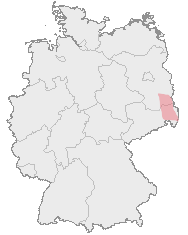Sorbian languages
| Sorbian | |
|---|---|
| Wendish, Lusatian | |
| Ethnicity: | Sorbs |
| Geographic distribution: |
Lusatia |
| Linguistic classification: |
Indo-European
|
| Subdivisions: | |
| ISO 639-2 / 5: | |
| Glottolog: | sorb1249 |

The Sorbian-speaking region in Germany
|
|
The Sorbian languages (Upper Sorbian: Serbsce; Lower Sorbian: Serbski) are two closely related languages spoken by the Sorbs, a Slavic minority in the Lusatia region of eastern Germany. They are classified under the West Slavic branch of the Indo-European languages. Historically the languages have also been known as or Lusatian. Their collective ISO 639-2 code is wen. They are closely related to Polish, Kashubian, Czech and Slovak.
There are two literary languages: Upper Sorbian (hornjoserbsce), spoken by about 40,000 people in Saxony, and Lower Sorbian (dolnoserbski) spoken by about 10,000 people in Brandenburg. The area where the two languages are spoken is known as Lusatia (Łužica in Upper Sorbian, Łužyca in Lower Sorbian, or Lausitz in German).
After the settlement of the formerly Germanic territories (the part largely corresponding to the former East Germany) by the Sorbs' Slavic ancestors in the 5th and 6th centuries, the Sorbian language (or its predecessors) had been in use in much of what was the southern half of East Germany for several centuries, and still had its stronghold in (Upper and Lower) Lusatia, where it enjoys national protection and fostering to the present day. Outside Lusatia, it has been superseded by German, following official discrimination from the 13th century on. The printed language developed around the main Bible translations into Sorbian.
...
Wikipedia
